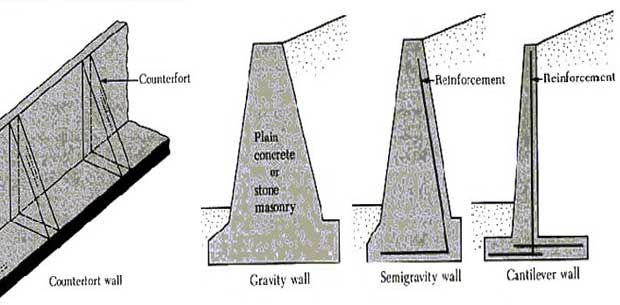
Retaining wall is a relatively rigid wall used for supporting the soil mass laterally so that the soil can be retained at different levels on the two sides.
Contents:
Types of retaining wall
The most common type of retaining walls is classified as under:
Gravity Retaining Wall
These walls depend upon their weight for stability. The walls are usually constructed of plain concrete or masonry. Such walls are not economical for large heights.
Semi-gravity Retaining Wall
The size of the section of a gravity retaining wall may be reduced if a small amount of reinforcement is provided near the back face. Such walls are known as semi-gravity walls.
Cantilever Retaining Wall
Cantilever retaining walls are made of reinforced cement concrete. The wall consists of a thin stem and a base slab cast monolithically. This type of wall is found to be economical upto a height of 6 to 8 m.
Counterfort Retaining Wall
Counterfort Retaining walls have thin vertical slabs, known as counterforts, spaced across the vertical steam at regular intervals. The counterforts tie the vertical stem with the base slab. Thus the vertical stem and the base slab span between counterfors. The purpose of providing the counterforts is to reduce the shear force and bending moments in the vertical stem and the base slab. The counterfort retaining walls are economical for a height more than 6 to 8 m.
Principles of the Designs of retaining wall
Before the actual design, the soil parameters that influence the earth pressure and the bearing capacity of the soil must be evaluated. These include the unit weight of the soil, the angle of shearing resistance, the cohesion intercept and the angle of wall friction. Knowing these parameters, the lateral earth pressures and the bearing capacity of the soil can be determined. After the earth pressures are determined, the retaining walls as whole is checked for stability against sliding, overturning, bearing capacity failure & tension.
Other modes of failure of retaining walls
In addition to the three types of failures i.e. sliding, overturning and bearing failure, a retaining wall may fail in the following two modes if the soil underneath is weak.
Shallow Shear Failure: This type of failure occurs along a cylindrical passing through the heel of the retaining wall. The failure takes place because of the excessive shear stresses along the cylindrical surface within the soil mass. However, it has generally been found that the factor of safety against horizontal sliding is lower than that for the shallow shear failure. Consequently, if the factor of safety against sliding is greater about 1.5, shallow shear failure is not likely to occur.
Deep shear failure: This type of shear failure occurs along a cylindrical surface, when there is a weak layer of soil underneath the wall a depth of about 1.5 times the height of the wall. The critical failure surface is determined by trial and error procedures.

